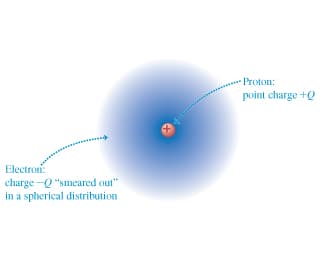A hydrogen atom is made up of a proton of charge +Q = −1.60×10-19 C and an electron of charge −Q = −1.60×10−19 C. The proton may be regarded as a point charge at r = 0, the center of the atom. The motion of the electron causes its charge to be "smeared out" into a spherical distribution around the proton (Figure 1), so that the electron is equivalent to a charge per unit volume of ρ(r)=−(Q/πa03)e−2r/a0, where a0 = 5.29×10-11m is called the Bohr radius.
(a) Find the total amount of the hydrogen atom's charge that is enclosed within a sphere with radius r centered on the proton.
(b) Find the electric field (magnitude and direction) caused by the charge of the hydrogen atom as a function of r.
(c) Make a graph as a function of r of the ratio of the electric-field magnitude E to the magnitude of the field due to the proton alone.
Answer the following questions too, continued on those previous three questions:
1. Consider a thin spherical shell centered on the proton, with radius r' and infinitesimal dr'. Since the shell is so thin, every point within the shell is at essentially the same radius from the proton. Hence the amount of electron charge within this shell is equal to the electron charge density ρ(r') at this radius multiplied by the volume dV of the shell. What is dV in terms of r'?
2. The total electron charge within a radius r equals the integral of ρ(r')dV from r'=0 to r'=r. Set up this integral (but don't solve it yet) and use it to write an expression for the total charge (including the proton) within a sphere of radius r.
3. Integrate your expression from question 2 to find the charge within radius r.
4. Use Gauss's Law and your results from question 3 to find the electric field at a distance r from the proton.
5. Find the ratio referred to in part (c) and graph it versus r.
6. How do your results for the enclosed charge and the electric-field magnitude behave in the limit r approaches to 0? or r approaches to infinity? Explain your results.

Trending now
This is a popular solution!
Step by step
Solved in 3 steps with 3 images









